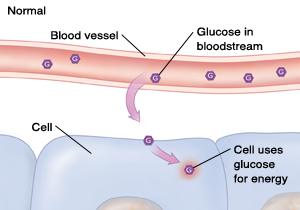Prediabetes
You have been diagnosed with prediabetes. This means that the level of sugar (glucose) in your blood is higher than normal but not high enough to be labeled as diabetes. If you have prediabetes, you are at risk for type 2 diabetes. Type 2 diabetes is when the level of glucose in the blood reaches a certain high level.
With prediabetes, your blood sugar hasn’t reached this point yet. But it's higher than normal. It's vital to make lifestyle changes to lower your blood sugar and prevent diabetes.
Why worry about prediabetes?
Prediabetes is when the body’s cells have trouble using glucose in the blood for energy. As a result, too much glucose stays in the blood. This can affect how your heart and blood vessels work. Without changes in your diet and lifestyle, the problem can get worse.
Once you have type 2 diabetes, it's ongoing (chronic). It needs to be managed for the rest of your life. Diabetes can harm your body and your health by damaging organs, such as your eyes and kidneys. It makes you more likely to have heart disease. And it can damage nerves and blood vessels.


Who is at risk for prediabetes?
The exact cause of prediabetes is not clear, however, some risk factors make a person more likely to have it. These include:
-
A family history of type 2 diabetes
-
Being overweight
-
Being over age 35
-
Have high blood pressure or high cholesterol
-
Having had gestational diabetes
-
Taking certain medicines
-
Not being physically active
-
Being African American
-
Being Asian American
-
Being Hispanic
-
Being Alaska Native
-
Being Native American
-
Being Pacific Islander
Diagnosing prediabetes
Prediabetes may have no symptoms. Or you may have some of the symptoms of diabetes (see below). The diagnosis is made with a blood test. You may have one or more of these blood tests:
-
Fasting glucose test. Blood is taken and tested after you have not eaten (fasted) for at least 8 hours. A normal test result is 99 milligrams per deciliter (mg/dL) or lower. Prediabetes is 100 to 125 mg/dL. Diabetes is 126 mg/dL or higher.
-
Glucose tolerance test. Your blood sugar is measured before and 2 hours after you drink a very sugary liquid. A normal test result is 139 mg/dL or lower. Prediabetes is 140 to 199 mg/dL. Diabetes is 200 mg/dL or higher. When this test is used for screening, make sure you have at least 5.25 ounces (150 grams) of carbohydrates per day for 3 days before the test.
-
Hemoglobin A1C (HbA1C). Your HbA1C is normal if it is below 5.7%. Prediabetes is 5.7% to 6.4%. Diabetes is 6.5% or higher.
Treating prediabetes
The best way to treat prediabetes is to lose at least 5% to 7% of your current weight and get at least 30 minutes of physical activity on most days of the week. If you sit for long periods of time, get up for short sessions of light activity every 30 minutes. These changes help your body’s cells use blood sugar better.
Even a small amount of weight loss can help. Work with your healthcare provider to make a plan to eat well and be more active. Keep in mind that small changes can add up. Other changes in your lifestyle may make you less likely to develop diabetes. Taking medicine such as metformin may help. Your provider can talk with you about these.
Stopping smoking will lower your risk of diabetes. Don't use e-cigarettes or vaping products. Also, limit alcohol intake.
Ask your healthcare provider for a referral to a lifestyle intervention program. This program will help you get to and stay at a 7% weight loss and increase your physical activity.
Follow-up care
If not treated, prediabetes can turn into diabetes. This is a serious health condition. Take steps to stop this from happening. Follow the treatment plan you have been given. You may have your blood glucose tested again in about 12 months.
Diabetes symptoms
Tell your healthcare provider if you have any of these symptoms:
-
Always feel very tired
-
Feel very thirsty or hungry much of the time
-
Have to urinate often
-
Lose weight for no reason
-
Feel numbness or tingling in your fingers or toes
-
Have cuts or bruises that don’t seem to heal
-
Have blurry vision